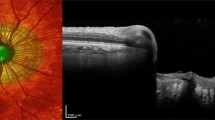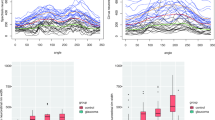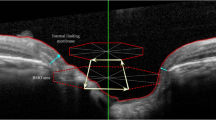Abstract
Purpose
To investigate monitoring slope-based features of the optic nerve head (ONH) cup as open-angle glaucoma (OAG) occurs.
Method
A dataset of 46 retrospective OCT cases was acquired from the SPECTRALIS Heidelberg Engineering OCT device. A set of five parameters, which are based on the ONH cup-incline, are measured on the OAG and normal subjects in the dataset. Then, three new ONH cup-shape indices were deduced. The ONH cup-incline parameters and ONH cup-shape indices are analyzed to estimate their clinical value.
Results
The statistical difference between measurements on normal and glaucoma eyes was remarkably significant for all of the analyzed parameters and indices (p value < 0.001).
Conclusions
The geometric shape of the ONH cup can be transferred to numerical parameters and indices. The proposed ONH cup-incline parameters and ONH cup-shape indices have shown suggestive clinical value to identify the development of OAG. As OAG appears, the top ONH cup-incline parameters decrease while the bottom ONH cup-incline parameters increase. The ONH cup-shape indices suggest capability to discriminate OAG from normal eyes.




Similar content being viewed by others
References
Kingman S (2004) Glaucoma is second leading cause of blindness globally. Bull World Health Organ 82:887–888
Cook C, Foster P (2012) Epidemiology of glaucoma: what is new? Can J Opthalmol 47:223–226
Quigley HA, Broman AT (2006) The number of people with glaucoma worldwide in 2010 and 2020. Br J Ophthalmol 90:262–267
Thomas R, Parikh RS (2006) How to assess a patient for glaucoma. Community Eye Health 19:36–37
Gelikonov VM, Gelikonov GV, Dolin LS et al (2003) Optical coherence tomography: physical principles and applications. Laser Phys 13:692–702
Addepalli UK, Ganesh BJ, Chandrasekhar G et al (2013) Agreement of glaucoma specialists and experienced optometrists in gonioscopy and optic disc evaluation. J Optom 6:212–218
Bussel II, Wollstein G, Schuman JS (2014) OCT for glaucoma diagnosis, screening, and detection of glaucoma progression. Br J Ophthalmol 98(Suppl. 2):ii15–ii19
Firat PG, Doganay S, Demirel EE, Colak C (2013) Comparison of ganglion cell and retinal nerve fiber layer thickness in primary open-angle glaucoma and normal tension glaucoma with spectral-domain OCT. Graefes Arch Clin Exp Ophthalmol 251:831–838
Ramdas WD, Van Koolwijk LME, Lemij HG et al (2011) Common genetic variants associated with open-angle glaucoma. Hum Mol Genet 20:2464–2471
Narooie-Nejad M, Paylakhi SH, Shojaee S et al (2009) Loss of function mutations in the gene encoding latent transforming growth factor beta binding protein 2, LTBP2, cause primary congenital glaucoma. Hum Mol Genet 18:3969–3977
Skarie JM, Link BA (2008) The primary open-angle glaucoma gene WDR36 functions in ribosomal RNA processing and interacts with the p53 stress–response pathway. Hum Mol Genet 17:2474–2485
Vithana EN, Aung T, Khor CC et al (2011) Collagen-related genes influence the glaucoma risk factor, central corneal thickness. Hum Mol Genet 20:649–658
Yaqoob Z, Wu J, Yang C (2005) Spectral domain optical coherence tomography: a better OCT imaging strategy. Mol Imaging 39:S6–S13
Dubois A, Grieve K, Moneron G et al (2004) Ultrahigh-resolution full-field optical coherence tomography. Appl Opt 43:2874–2883
Wang J, Dainty C, Podoleanua A (2008) Multiple delay lines full-field optical coherence tomography. 1st Canterbury workshop on optical coherence tomography and adaptive optics, Canterbury. doi:10.1117/12.822154
Subhash HM (2011) Full-field and single-shot full-field optical coherence tomography: a novel technique for biomedical imaging applications. Adv Opt Technol. doi:10.1155/2012/435408
Savini G, Carbonelli M, Parisi V, Barboni P (2011) Repeatability of optic nerve head parameters measured by spectral-domain OCT in healthy eyes. Ophthalmic Surg Lasers Imaging 42:209–215
Aref AA, Budenz DL (2010) Spectral Domain Optical Coherence Tomography in the Diagnosis and Management of Glaucoma. Ophthalmic Surgery, Lasers & Imaging 41(Suppl.):S15–S27
Savini G, Barboni P, Parisi V, Carbonelli M (2012) The influence of axial length on retinal nerve fiber layer thickness and optic-disc size measurements by spectral-domain OCT. Br J Ophthalmol 96:57–61
Kim NR, Lee ES, Seong GJ, Choi EH, Hong S, Kim CY (2010) Spectral-domain optical coherence tomography for detection of localized retinal nerve fiber layer defects in patients with open-angle glaucoma. Arch Opthalmol 128:1121–1128
Gupta PK, Asrani S, Freedman SF, El-Dairi M, Bhatti MT (2011) Differentiating glaucomatous from non-glaucomatous optic nerve cupping by optical coherence tomography. Open Neurol J 5:1–7
Kaw SM, Martinez JM, Tumbocon JA, Atienza N (2012) Correlation of average RNFL thickness using the STRATUS OCT with the perimetric staging of glaucoma. Philipp Acad Ophthalmol 37:19–23
Monteiro M, Hokazono K, Cunha L, Oyamada M (2013) Correlation between multifocal pattern electroretinography and Fourier-domain OCT in eyes with temporal hemianopia from chiasmal compression. Graefes Arch Clin Exp Ophthalmol 251:903–915
Nukada M, Hangai M, Mori S et al (2011) Detection of localized retinal nerve fiber layer defects in glaucoma using enhanced spectral-domain optical coherence tomography. Ophthalmology 118:1038–1048
Dong J, Chihara E (2001) Slope analysis of the optic disc in eyes with ocular hypertension and early normal tension glaucoma by confocal scanning laser ophthalmoscope. Br J Ophthalmol 85:56–62
Cullinane AB, Waldock A, Diamond JP, Sparrow JM (2002) Optic disc cup slope and visual field indices in normal, ocular hypertensive and early glaucomatous eyes. Br J Ophthalmol 86:555–559
Töteberg-Harms M, Sturm V, Knecht PB, Funk J, Menke MN (2012) Repeatability of nerve fiber layer thickness measurements in patients with glaucoma and without glaucoma using spectral-domain and time-domain OCT. Graefes Arch Clin Exp Ophthalmol 250:279–287
Khanal S, Davey PG, Racette Thapa M (2015) Intra eye retinal nerve fiber layer and macular thickness asymmetry measurements for the discrimination of primary open-angle glaucoma and normal tension glaucoma. J Optomol. doi:10.1016/j.optom.2015.10.002
Babu G, Devi S (2009) Glaucoma diagnosis of morphological processing in optical coherence tomography. In: International Conference on Computer Engineering and Applications IPCSIT, vol 2, pp 343–347
Huang ML, Chen HY, Huang JJ (2007) Glaucoma detection using adaptive neuro-fuzzy inference system. Expert Syst Appl 32:458–468
Bock R, Meier J, Nyúl LG, Hornegger J, Michelson G (2010) Glaucoma risk index: automated glaucoma detection from color fundus images. Med Image Anal 14:471–481
Yousefi S, Goldbaum MH, Balasubramanian M et al (2013) Glaucoma progression detection using structural retinal nerve fiber layer measurements and functional visual field points. IEEE Trans Biomed Eng 00:1–12
Koprowski R, Rzendkowski M, Wróbel Z (2014) Automatic method of analysis of OCT images in assessing the severity degree of glaucoma and the visual field loss. BioMed Eng. doi:10.1186/1475-925X-13-16
Bland M (2000) Comparing the means of small samples. An introduction to medical statistics, 3rd edn. Oxford University Press, Oxford, pp 156–183
Girkin CA, Sample PA, Liebmann JM et al (2010) African Descent and Glaucoma Evaluation Study (ADAGES), Ancestry differences in optic disc, retinal nerve fiber layer, and macular structure in healthy subjects. Arch Ophthalmol 128:541–550
Acknowledgments
Authors would like to present their thanks and gratefulness to the medical staff in the ophthalmology clinic at the Specialty hospital in Amman, Jordan, for their kindness and cooperation to collect the research data.
Author information
Authors and Affiliations
Corresponding author
Ethics declarations
Conflict of interest
The authors declare that they have no conflict of interest.
Ethical approval
The subjects in this experiment are retrospective studies.
Rights and permissions
About this article
Cite this article
Al-Hinnawi, AR.M., Al-Naami, B.O. & Al-Latayfeh, M.M. Optic nerve head slope-based quantitative parameters for identifying open-angle glaucoma on SPECTRALIS OCT images. Int Ophthalmol 37, 979–988 (2017). https://doi.org/10.1007/s10792-016-0362-9
Received:
Accepted:
Published:
Issue Date:
DOI: https://doi.org/10.1007/s10792-016-0362-9




